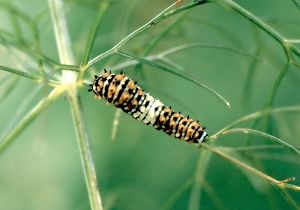
Tiger Swallowtail | 
Black Swallowtail |
  Several types of swallowtail butterflies visit us, including tiger (Papilio glaucus), giant (Haclides cresphontes), and black (Papilio polyxenes asterius). The only one that spends its whole life cycle where I can see it is the black swallowtail. The larvae feast on fennel, which grows for two or three years before it dies, meanwhile producing plenty of seedlings. Several types of swallowtail butterflies visit us, including tiger (Papilio glaucus), giant (Haclides cresphontes), and black (Papilio polyxenes asterius). The only one that spends its whole life cycle where I can see it is the black swallowtail. The larvae feast on fennel, which grows for two or three years before it dies, meanwhile producing plenty of seedlings.
The fennel usually gets a good headstart because it grows well in the cold months, coming back quickly from freezes, so there is plenty for the first caterpillars to eat. They start out tiny, bumpy, and dark colored with a white saddle marking. They are pretty hard to see, even in the midst of the feathery green foliage. As they get bigger, they take on a striped and spotted pattern. Since the caterpillars are rather soft and lack spines, they have a different means of defense. When threatened, they stick a two-pronged, orange extension out from their head. This probably has some noxious chemical on it, but I've never noticed any bad smell. It is, however, very wet looking and sort of sticky.
 
When the caterpillar is ready to pupate, it attaches a strand of silk to the stem of the fennel, which acts like a sling to hold it upright, and also attaches itself at the lower end. It sheds its skin and becomes a green chrysalis. The adult emerges in the usual way, with soft wings and a big soft body. The best time to photograph the butterflies is just before they are ready to fly away, but are still cooperatively immobile.
Unfortunately, very few of the caterpillars make it past their first few days, since they seem to be a favorite prey of wasps, in spite of their orange defense protuberance. I was photographing an inch long larva once and saw a wasp land near it. It seemed to search around for awhile, then headed straight to the caterpillar and bit into it. It quickly devoured a small portion, then flew off with the rest, presumably to feed its brood. After the early part of the spring, there are far more wasps than caterpillars in the fennel.
 Giant Swallowtail
Giant Swallowtail
|




 Several types of swallowtail butterflies visit us, including tiger (Papilio glaucus), giant (Haclides cresphontes), and black (Papilio polyxenes asterius). The only one that spends its whole life cycle where I can see it is the black swallowtail. The larvae feast on fennel, which grows for two or three years before it dies, meanwhile producing plenty of seedlings.
Several types of swallowtail butterflies visit us, including tiger (Papilio glaucus), giant (Haclides cresphontes), and black (Papilio polyxenes asterius). The only one that spends its whole life cycle where I can see it is the black swallowtail. The larvae feast on fennel, which grows for two or three years before it dies, meanwhile producing plenty of seedlings.

